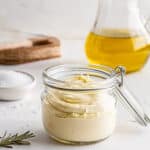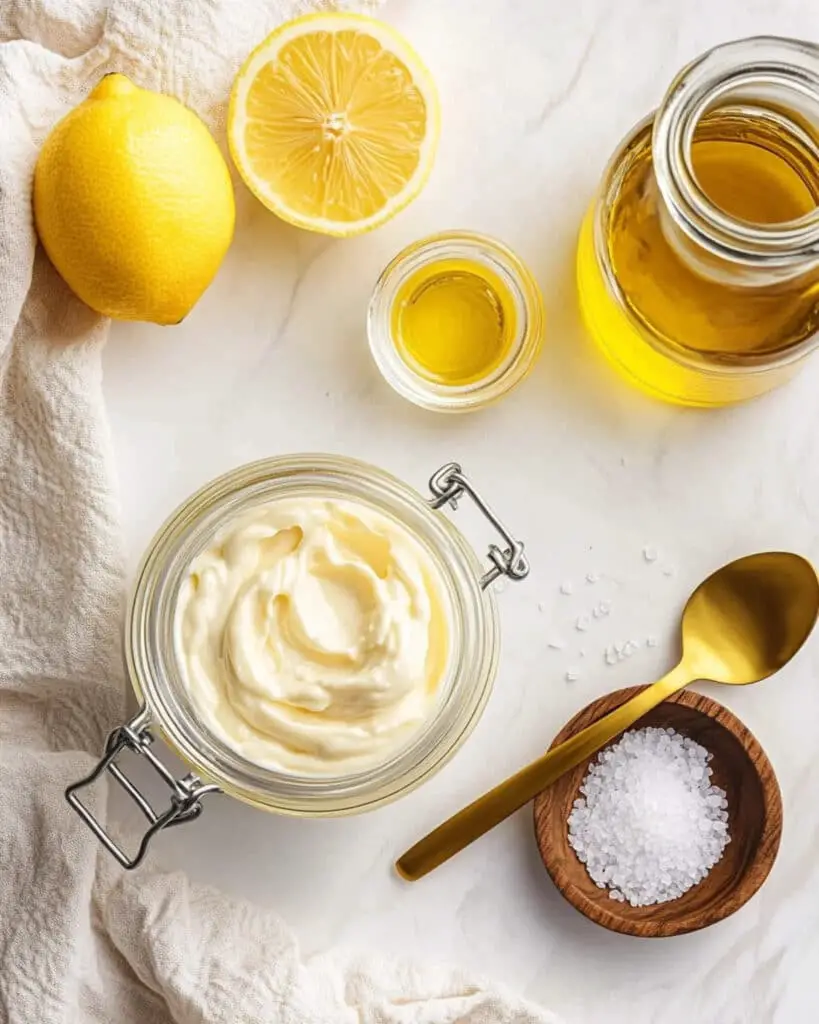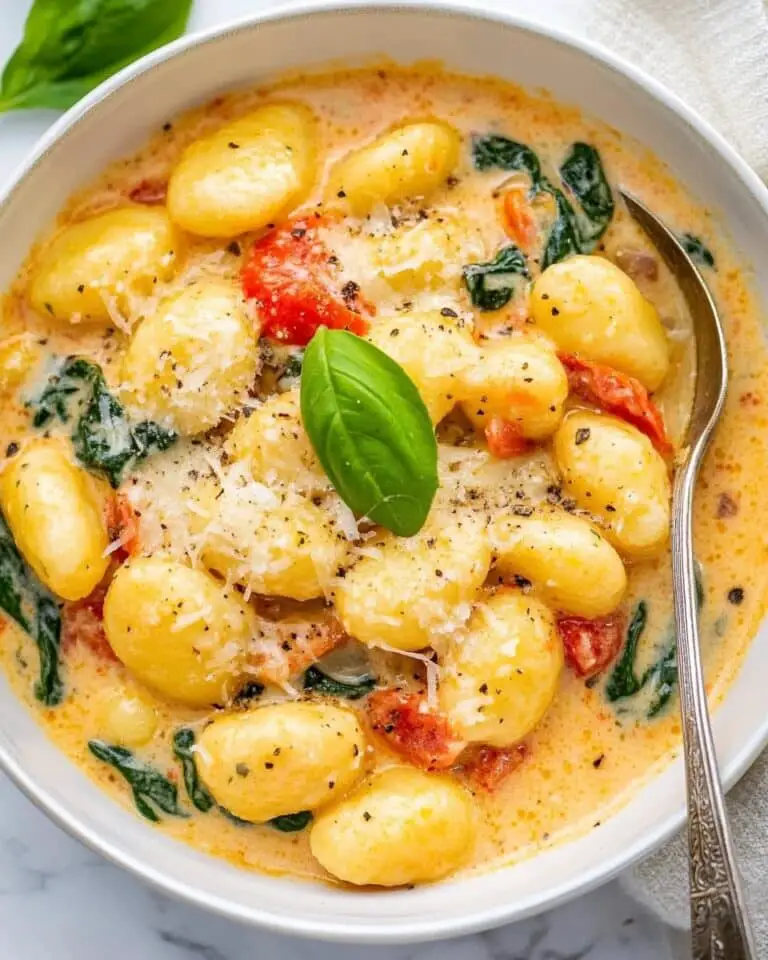This silky, luxurious homemade mayonnaise transforms ordinary sandwiches and salads into culinary masterpieces in just 5 minutes. With simple pantry ingredients and a stick blender, you’ll create a creamy condiment that makes store-bought versions pale in comparison. Perfect for mayo enthusiasts who appreciate fresh, preservative-free ingredients and customizable flavors without any fuss.
Why You’ll Love This Recipe
- Incredibly Fast: You’ll have fresh mayonnaise ready in literally 5 minutes—faster than a trip to the store!
- Pure Ingredients: Skip the preservatives and additives found in commercial mayonnaise and enjoy the clean taste of simple ingredients you can pronounce.
- Customizable: Once you master the basic recipe, you can create endless variations to suit your taste preferences or complement specific dishes.
- Cost-Effective: Make gourmet-quality mayonnaise for a fraction of the price of specialty store brands.
Ingredients You’ll Need
- Egg: The foundation of mayonnaise, providing both structure and richness. Using a fresh, room-temperature egg helps create a more stable emulsion.
- Dijon Mustard: Acts as an emulsifier to help bind oil and water together, while adding a subtle tangy depth that elevates the flavor profile.
- Lemon Juice: Adds brightness and acidity that balances the richness of the oil and egg. This acidic component also helps preserve your mayo.
- Salt: Enhances all the flavors and transforms basic ingredients into something special. Don’t skip this!
- Canola Oil: The neutral flavor lets other ingredients shine through. Its light consistency creates that perfect mayo texture without overwhelming the palate.
Note: You’ll find the complete list of ingredients, along with their exact measurements, in the printable recipe card at the bottom of this post.
Variations
Flavor Boosters
- Garlic Aioli: Add 1-2 cloves of minced garlic for a Mediterranean-inspired spread perfect for sandwiches or as a dip.
- Herb Mayo: Mix in 1-2 tablespoons of finely chopped fresh herbs like dill, basil, tarragon, or chives after blending.
- Spicy Mayo: Incorporate a teaspoon of sriracha, hot sauce, or a pinch of cayenne for a kick that pairs wonderfully with burgers or fish tacos.
Oil Substitutions
- Olive Oil Blend: Replace up to 1/3 of the canola oil with olive oil for a more Mediterranean flavor (using all olive oil can make the mayo bitter).
- Avocado Oil: Substitute equal amounts for a heart-healthy alternative with a mild, buttery taste.
How to Make Homemade Mayonnaise
Step 1: Prepare Your Equipment
Grab a tall, narrow container that fits your stick blender snugly. This setup is crucial for proper emulsification and creamy results.
Step 2: Combine Base Ingredients
Place the egg, Dijon mustard, lemon juice, and salt in your container. These ingredients will form the foundation of your emulsion.
Step 3: Begin Emulsification
Position your stick blender so it sits directly on the egg yolk at the bottom of the container. Turn it on and hold it steady for about 10-15 seconds as the mixture begins to thicken and turn white around the blender head.
Step 4: Add Oil and Continue Blending
With the blender running, slowly pour in the oil in a thin, steady stream. As you blend, gently move the blender up and down to incorporate air and ensure all oil is properly emulsified.
Step 5: Check Consistency
After about 1-2 minutes of blending, you should have thick, creamy mayonnaise. If it seems too thin, add a bit more oil and continue blending until you reach your desired consistency.
Pro Tips for Making the Recipe
- Room Temperature Ingredients: Allow the egg to come to room temperature for better emulsification.
- Container Matters: Use a container just slightly wider than your stick blender for the most efficient blending and quickest emulsion.
- Patience with Oil: Add the oil slowly, especially at the beginning. Rushing this step can break your emulsion.
- Fixing Broken Mayo: If your mayo separates, don’t panic! Add another egg yolk to a clean bowl, then slowly whisk in the broken mixture until it comes together.
- Fresh Eggs: For both safety and quality, use the freshest eggs possible when making homemade mayonnaise.
How to Serve

Perfect Pairings
- Elevate sandwiches and burgers with a generous spread of your homemade creation.
- Use as a base for potato salad, coleslaw, or tuna salad for incredible depth of flavor.
- Serve alongside roasted vegetables or fresh artichokes as an elegant dipping sauce.
Gourmet Touches
- Drizzle over grilled fish or spread on bread for the ultimate BLT experience.
- Mix with a little extra lemon juice and herbs for a quick and impressive salad dressing.
Make Ahead and Storage
Storing Leftovers
Store your mayonnaise in an airtight container in the refrigerator for up to one week. The fresher the egg, the longer your mayo will last.
Appearance Changes
If your mayonnaise separates slightly during storage, simply give it a quick whisk before using—it’ll come right back together.
Food Safety Note
Since this recipe contains raw egg, use within one week and keep refrigerated at all times. Consider using pasteurized eggs if serving to pregnant women, young children, the elderly, or those with compromised immune systems.
FAQs
-
Can I make mayonnaise without a stick blender?
Yes, you can use a regular blender or food processor, though the technique differs slightly. Start by processing the egg, mustard, lemon juice, and salt, then add the oil in a very slow, thin stream while the machine runs. You can also make it by hand with a whisk, but be prepared for a serious arm workout!
-
Why did my mayonnaise not thicken?
The most common reason is adding the oil too quickly, especially at the beginning of the process. Start over with a new egg and add your failed batch to it very slowly, as if it were oil. Other factors might include using cold ingredients or insufficient blending time.
-
Can I use egg substitute or just egg whites?
Traditional mayonnaise requires the whole egg, particularly the yolk which contains lecithin, a natural emulsifier. While some recipes use just yolks, using egg substitutes typically won’t work for homemade mayonnaise.
-
How can I make this recipe safer regarding raw eggs?
For added safety, use pasteurized eggs available at many grocery stores. Alternatively, you can pasteurize eggs at home by holding them at 135°F (57°C) for about 75 minutes using a sous vide setup or very precise thermometer control.
Final Thoughts
This homemade mayonnaise recipe will completely transform how you think about this kitchen staple. Once you experience the silky texture and fresh flavor that simply can’t be found in store-bought versions, there’s no going back! The five minutes you’ll spend making it will reward you with a versatile condiment that makes everything from simple sandwiches to elaborate salads taste like they came from a gourmet kitchen. Trust me—give this recipe a try, and you’ll wonder why you ever settled for the jarred stuff!
Print
Homemade Mayonnaise Recipe
- Prep Time: 5 minutes
- Cook Time: 0 minutes
- Total Time: 5 minutes
- Yield: 1 cup
- Category: Sauces-condiments
- Method: Blending
- Cuisine: International
- Diet: Vegetarian
Description
Homemade mayonnaise is a rich, creamy, and versatile condiment that adds incredible flavor to your dishes. This quick and easy recipe requires just a handful of ingredients and a stick blender, making it perfect for whipping up fresh mayo at home. Customize it with your choice of oils or add unique flavors for a personalized touch.
Ingredients
- 1 large egg
- 1 tbsp dijon mustard
- 1 tbsp lemon juice
- 1/4 tsp salt
- 1 cup canola oil
Instructions
- Prepare the Ingredients
Add the egg, dijon mustard, lemon juice, and salt into a tight container suitable for blending. This setup will help ensure the perfect emulsion when blending. - Start Blending
Using a stick blender, begin pulsing while streaming in the canola oil very slowly. This gradual addition of oil is crucial to achieving a smooth and stable emulsion. While blending, gently lift the stick blender to allow some air circulation into the mixture. - Emulsify and Thicken
Blend the mixture for a few minutes until it emulsifies and thickens into a creamy mayonnaise. The egg, mustard, and oil work together to create a beautifully silky consistency. - Adjust Consistency (if needed)
If the mayonnaise is still too liquid after blending for a couple of minutes, add a bit more oil and blend again until the desired thickness is achieved.
Notes
- For an earthy and richer flavor, replace ⅓ cup of canola oil with ⅓ cup of olive oil.
- To make aioli, add one clove of minced garlic to the container and blend it with the rest of the ingredients.
- Experiment with flavors: stir in hot sauce, ranch seasoning, or other spices to try out various flavored mayonnaises.
- This recipe can be doubled if you use mayonnaise frequently or need a larger batch for salads or other dishes.
Nutrition
- Serving Size: 1 tbsp
- Calories: 90
- Sugar: 0g
- Sodium: 60mg
- Fat: 10g
- Saturated Fat: 1g
- Unsaturated Fat: 9g
- Trans Fat: 0g
- Carbohydrates: 0g
- Fiber: 0g
- Protein: 0g
- Cholesterol: 10mg









